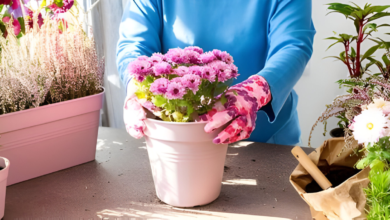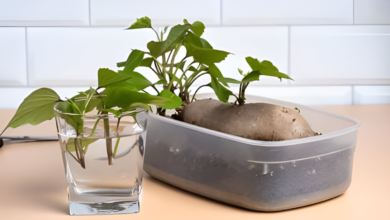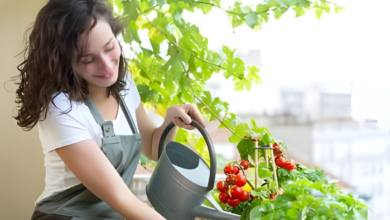The Ultimate Guide to Growing Tomatoes Outside in Pots

Table of Contents:
- Choosing the Right Tomato Varieties for Container Gardening
- Selecting the Perfect Pot and Soil for Tomato Growth
- Optimal Placement and Sunlight Requirements
- Watering and Feeding Needs of Potted Tomato Plants
- Pruning and Training Techniques for Healthy Growth
- Identifying and Managing Common Tomato Pests and Diseases
- Dealing with Environmental Challenges in Outdoor Tomato Cultivation
- Harvesting and Storing Tomatoes Grown in Pots
- Creative Ways to Use Homegrown Tomatoes
- Additional Tips for Successful Container Tomato Gardening
Choosing the Right Tomato Varieties for Container Gardening
When selecting tomato varieties for container gardening, I consider several factors to ensure successful growth. The key is choosing compact or dwarf varieties that thrive in confined spaces. Here’s what I look for:
- Determinate vs. Indeterminate: I prefer determinate varieties for container gardening as they have a more compact growth habit and are easier to manage in limited space.
- Container Size: Consider the size of your container when choosing tomato varieties. Smaller containers are suitable for dwarf cherry tomatoes, while larger containers can accommodate larger varieties.
- Sunlight Requirements: Make sure the tomato variety you choose matches the amount of sunlight your container receives. Some varieties require full sun, while others can tolerate partial shade.
- Yield: If you have limited space, opt for varieties that are prolific producers to maximize your harvest in a small area.
- Disease Resistance: Look for varieties that are resistant to common tomato diseases to prevent issues in a confined environment.
Some of my favorite tomato varieties for container gardening include:
- Tiny Tim: A tiny determinate variety perfect for small containers or hanging baskets.
- Patio Princess: A compact determinate cherry tomato that thrives in containers.
- Bush Early Girl: A determinate variety with early maturity, ideal for small spaces.
- Tumbling Tom: A trailing cherry tomato variety suitable for hanging containers.
- Roma: A determinate paste tomato great for compact gardens or containers.
By considering these factors and selecting the right tomato varieties, you can enjoy a bountiful harvest of fresh tomatoes from your container garden.
Selecting the Perfect Pot and Soil for Tomato Growth
I choose the right pot size for tomatoes based on their root system. I go for containers that are at least 18 inches in diameter and have a depth of 24 inches. This provides enough space for the roots to grow and prevents the plant from becoming root-bound.
When selecting a pot for tomatoes, I opt for containers made of sturdy materials like plastic or ceramic. This ensures durability and stability for the plants as they grow. Additionally, I make sure the pots have sufficient drainage holes at the bottom to prevent waterlogging, which can lead to root rot.
In terms of soil, I prefer a well-draining potting mix that is rich in organic matter. I make my own mix using equal parts of peat moss, perlite, and compost. This combination provides good aeration for the roots and supplies essential nutrients for healthy growth.
I avoid using garden soil in pots as it tends to compact and restrict root growth. Instead, I opt for a lightweight potting mix specifically formulated for container gardening. This type of soil allows for proper drainage and root development, leading to robust tomato plants.
To ensure optimal growth, I also incorporate a slow-release fertilizer into the soil mix before planting. This provides a steady supply of nutrients to the tomatoes as they grow, promoting strong stems and abundant fruit production.
By choosing the right pot size and soil mix for tomatoes, I set the stage for successful growth and a bountiful harvest.
Optimal Placement and Sunlight Requirements
When growing tomatoes outside in pots, the placement of your containers is crucial for the success of your plants. Here are some essential tips for the optimal placement and sunlight requirements:
- Choose a Sunny Spot: Place your tomato pots in a location that receives at least 6-8 hours of sunlight per day. Tomatoes thrive in full sun, so make sure to select a spot with ample sunshine exposure.
- Avoid Shade: Keep your tomato plants away from areas with too much shade. Lack of sunlight can result in leggy growth, fewer flowers, and reduced fruit production. Aim for a sunny, well-ventilated location.
- Rotate Pots: If possible, rotate your pots every few days to ensure all sides of the plant receive equal amounts of sunlight. This practice helps prevent your tomato plants from leaning or reaching towards the light source unevenly.
- Use Reflective Surfaces: Placing reflective surfaces like mirrors or white walls near your tomato plants can help redirect sunlight onto the foliage, increasing light exposure and promoting healthy growth.
- Protect from Harsh Sun: While tomatoes love sun, intense afternoon sun in excessively hot climates can scorch the plants. Consider providing some afternoon shade by strategically placing your pots where they receive morning sun and partial shade in the afternoon.
- Adjust as Needed: Monitor your plants regularly and adjust their placement if you notice signs of sunburn, wilting, or stress. Remember, finding the right balance of sunlight is key to growing healthy and productive tomato plants in pots.
By following these placement and sunlight tips, you can create an optimal growing environment for your tomatoes in pots, ensuring a bountiful harvest of delicious homegrown fruits.
Watering and Feeding Needs of Potted Tomato Plants
When it comes to watering your potted tomato plants, consistency is key. I ensure that the soil remains consistently moist but not waterlogged. A good rule of thumb is to water deeply once or twice a week, depending on the weather. During hot summer days, I sometimes water my tomato plants every day to prevent them from drying out.
Feeding your potted tomato plants is also crucial for their growth and fruit production. I like to use a balanced fertilizer with equal parts nitrogen, phosphorus, and potassium. I usually start fertilizing my tomato plants once a week when they begin to flower. Remember not to over-fertilize, as this can lead to excessive foliage growth at the expense of fruit development.
When it comes to fertilizing potted tomato plants, I prefer using organic options such as compost or well-decomposed manure. These organic fertilizers not only provide essential nutrients but also improve the overall soil structure and drainage. Just be cautious not to apply too much, as it can cause nutrient imbalances in the soil.
Remember, the key to success with potted tomato plants is to strike a balance with watering and feeding. Observing your plants regularly and adjusting your watering and feeding schedule accordingly will help you achieve healthy, thriving tomato plants with bountiful harvests.
Pruning and Training Techniques for Healthy Growth
I have found that properly pruning and training tomato plants can significantly improve their health and yield. Here are some techniques I recommend for optimal growth:
- Remove Suckers: Suckers are the small shoots that grow between the main stem and branches of the tomato plant. By removing these suckers, I ensure that the plant’s energy is focused on fruit production rather than unnecessary growth.
- Support System: Providing a support system for tomato plants is crucial to prevent them from sagging or breaking under the weight of the fruit. I like to use stakes or cages to support the plants as they grow taller.
- Regular Pruning: Regularly pruning the lower leaves of the tomato plant can help improve air circulation and reduce the risk of disease. I make sure to remove any yellowing or damaged leaves to keep the plant healthy.
- Pinching off the Tops: When the tomato plant reaches the desired height or has set enough fruit, I pinch off the tops to stop vertical growth. This encourages the plant to focus on ripening the existing fruit.
- Training Techniques: Training tomato plants to grow in a specific direction can help maximize sunlight exposure and airflow. I gently tie the branches to the support system using garden twine to encourage upward growth.
By implementing these pruning and training techniques, I have consistently seen healthier tomato plants with higher yields. It requires some effort, but the results are definitely worth it.
Identifying and Managing Common Tomato Pests and Diseases
When growing tomatoes outside in pots, it’s essential to keep an eye out for pests and diseases that can harm your plants. Here are some common tomato pests and diseases you may encounter, along with tips on how to manage them:
- Aphids: These small insects can cluster on the undersides of leaves, sucking sap from the plant. To control aphids, I recommend spraying the plant with a strong stream of water or applying insecticidal soap.
- Fungal Diseases: Diseases like early blight and powdery mildew can affect tomato plants. To prevent fungal diseases, ensure good air circulation around plants, avoid overhead watering, and remove any infected leaves promptly.
- Hornworms: These large green caterpillars can munch on tomato leaves and fruit. Handpick hornworms from your plants and destroy them or introduce natural predators like ladybugs.
- Blossom End Rot: This condition causes dark, sunken spots on the bottom of the tomato fruit and is often due to calcium deficiency or inconsistent watering. I recommend adding calcium to the soil and maintaining consistent moisture levels.
- Tomato Mosaic Virus: This virus results in mottled leaves and reduced fruit production. Unfortunately, there is no cure for tomato mosaic virus, so it’s crucial to remove and destroy infected plants to prevent its spread.
Remember to regularly inspect your tomato plants for any signs of pests or diseases and take prompt action to prevent them from causing significant damage. By being vigilant and proactive in managing common tomato pests and diseases, you can help your plants thrive and produce a bountiful harvest.
Dealing with Environmental Challenges in Outdoor Tomato Cultivation
I face various environmental challenges when growing tomatoes outdoors in pots. To combat these challenges effectively, I implement the following strategies:
- Extreme Temperatures: I protect my tomato plants from extreme temperatures by providing shade during scorching days and covering them with cloches or frost blankets in case of unexpected cold snaps.
- Wind Damage: I stake my tomato plants securely to prevent them from toppling over in strong winds, which can damage the stems and fruits. Additionally, I place windbreaks around my pots to reduce the impact of wind exposure.
- Heavy Rainfall: To prevent waterlogging and root rot due to heavy rainfall, I ensure proper drainage in my pots by adding rocks or perlite to the soil mix. I also tilt the pots slightly to allow excess water to drain out.
- Pests and Diseases: I regularly inspect my tomato plants for pests and diseases, removing any affected leaves or fruits promptly. I also practice crop rotation and use natural remedies like neem oil to keep pests at bay.
- Sunburn: To protect my tomato plants from sunburn, I apply a layer of mulch around the base of the plants to regulate soil temperature and reduce moisture loss. I also water my plants in the early morning to ensure they are hydrated before the sun is at its peak.
- Pollination: In case of poor pollination due to limited bee activity, I manually pollinate my tomato plants by gently shaking the flower clusters or using a small paintbrush to transfer pollen between flowers.
By proactively addressing these environmental challenges, I can ensure that my outdoor tomato cultivation is successful and yields a bountiful harvest.
Harvesting and Storing Tomatoes Grown in Pots
I always look forward to the rewarding task of harvesting tomatoes from my container garden. Here are some tips on how to properly harvest and store your homegrown tomatoes:
- Harvesting:
- When your tomatoes are ripe, they should have a deep color and give slightly when gently squeezed.
- To harvest, simply twist the tomato gently until it breaks free from the stem.
- I prefer to harvest in the morning when the fruits are cool and turgid, ensuring the best flavor and longevity.
- Storing:
- If you aren’t using your tomatoes right away, store them at room temperature, out of direct sunlight.
- Only refrigerate your tomatoes if they are very ripe and you need to slow down the ripening process.
- I love to preserve the flavor of my tomatoes by freezing them whole or turning them into sauces and canned products.
- Extended Harvest:
- As the season comes to an end, you can pick all green tomatoes left on the vine and ripen them indoors. Place them in a paper bag with a banana or apple to speed up the process.
Remember, harvesting and storing your tomatoes correctly is essential for preserving their flavor and freshness. Enjoy the fruits of your labor throughout the year by implementing these simple techniques.
Creative Ways to Use Homegrown Tomatoes
I love finding creative ways to use the abundance of homegrown tomatoes from my garden. Here are some of my favorite ways to make the most of these delicious fruits:
- Caprese Salad: There’s nothing quite like a classic Caprese salad with fresh tomatoes, mozzarella cheese, basil, and a drizzle of balsamic glaze. It’s simple yet so flavorful.
- Homemade Salsa: I enjoy making my own salsa using ripe tomatoes, onions, jalapenos, cilantro, lime juice, and a pinch of salt. It’s perfect for dipping tortilla chips or topping tacos.
- Bruschetta: Toasted slices of baguette topped with a mixture of diced tomatoes, garlic, basil, and olive oil make for a delightful appetizer or snack.
- Tomato Sauce: I love simmering fresh tomatoes with garlic, onions, and herbs to make a flavorful pasta sauce. It’s a great way to use up a lot of tomatoes at once.
- Tomato Soup: A creamy tomato soup made with roasted tomatoes, onions, and a touch of cream is soothing and comforting, especially on a cool evening.
- Stuffed Tomatoes: Hollowed-out tomatoes filled with a mixture of breadcrumbs, cheese, herbs, and maybe some cooked ground meat make for a tasty and impressive dish.
- Tomato Tart: A homemade tomato tart with a flaky crust, savory custard filling, and sliced tomatoes on top is a beautiful way to showcase fresh tomatoes.
- Sun-dried Tomatoes: I like to dry some of my tomatoes in the sun to make sun-dried tomatoes. They’re great for adding a burst of flavor to salads, pasta dishes, and more.
Experimenting with different recipes and trying new ways to use homegrown tomatoes adds a fun and delicious element to gardening. The possibilities are endless, and each dish allows the natural flavors of the tomatoes to shine.
Additional Tips for Successful Container Tomato Gardening
When it comes to container tomato gardening, there are a few additional tips that can help ensure a successful harvest:
- Choose the Right Container: Opt for containers that are at least 18 inches in diameter to provide ample space for root growth. Ensure the pots have drainage holes to prevent waterlogging.
- Select the Correct Tomato Variety: Consider the space you have available and choose determinate or dwarf tomato varieties for smaller containers. Indeterminate varieties are best suited for larger pots.
- Provide Adequate Support: Use stakes, trellises, or cages to support your tomato plants as they grow. This will help prevent the plants from toppling over due to the weight of the tomatoes.
- Monitor Watering Closely: Container tomatoes may need more frequent watering as pots can dry out quickly. Check the moisture level regularly and water deeply when the top inch of soil feels dry.
- Fertilize Regularly: Since the nutrients in container soil can deplete faster, regularly feed your tomato plants with a balanced fertilizer to promote healthy growth and ample fruit production.
- Prune for Optimal Growth: Remove suckers and lower leaves to improve air circulation and light penetration, promoting better fruit development and reducing the risk of diseases.
- Protect from Pests: Keep an eye out for common tomato pests such as aphids, whiteflies, and hornworms. Consider using natural remedies or insecticidal soaps to protect your plants.
- Rotate Your Containers: To prevent soil depletion and disease buildup, rotate the location of your containers each growing season if possible.
By following these additional tips, you can enhance the success of your container tomato gardening and enjoy a bountiful harvest of fresh, juicy tomatoes right from your own patio or balcony.




